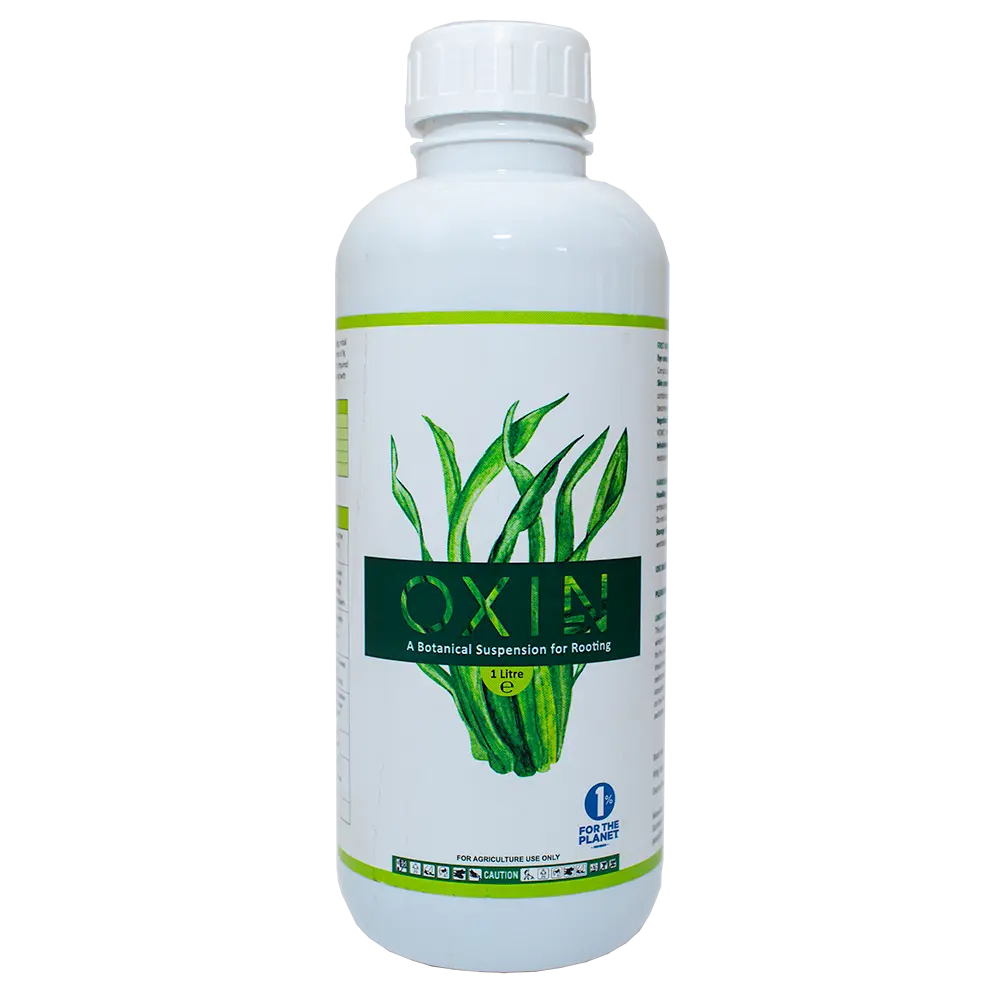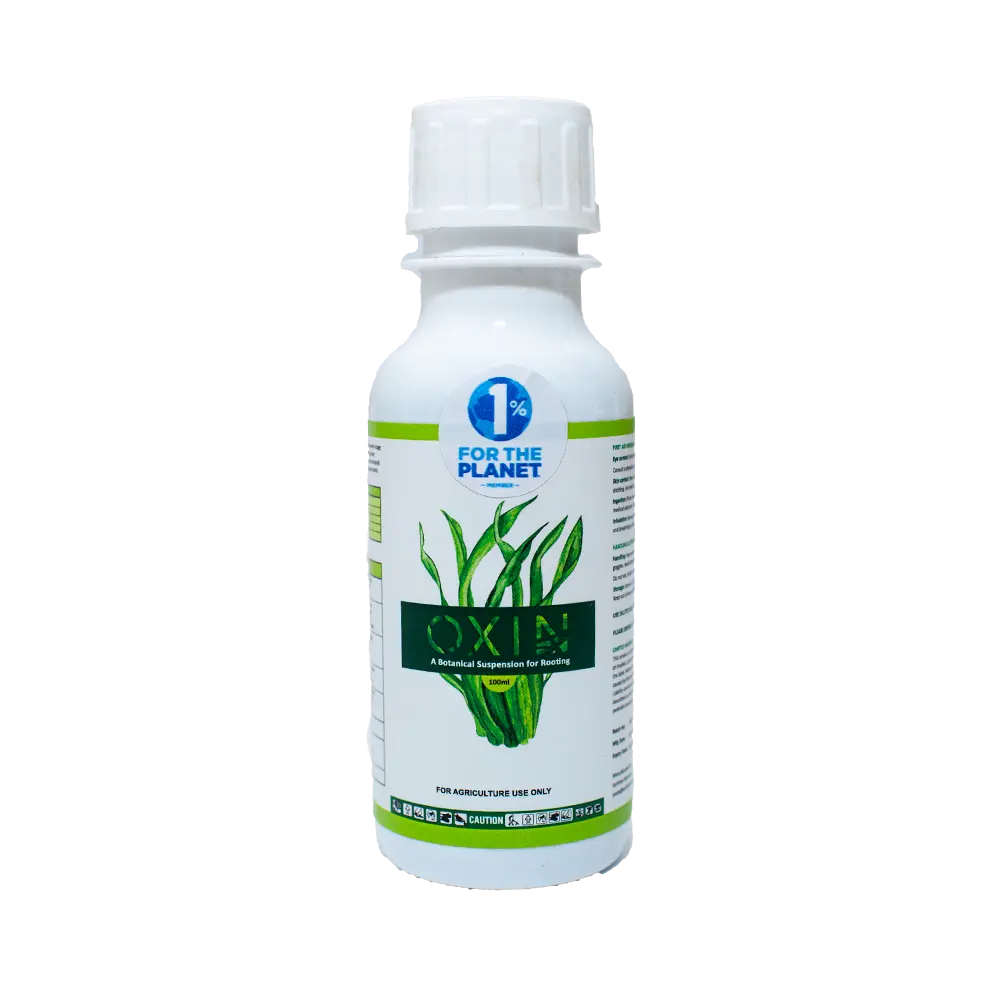
Oxin is an effective product that can prevent transplanting shock and helps roots establish quickly
About Oxin
The facts about our fast root growth solution.
- Oxin promotes cell division in cambium which increases growth in the stems and roots of plants. Mainly dicots and gymnosperms.
- Oxin is key in propagation and a cloning of plant sections. Oxin promotes cell division in the tissue culture. Plant tissue culture is a collection of techniques used to maintain or grow plant cells, tissues or organs under sterile conditions on a nutrient culture medium of known composition. It is widely used to produce clones of a plant in a method known as micropropagation.
- Oxin, when applied to the flowers of certain species, has the ability to initiate development of fruit without pollination. The process produces a sterile fruit that lacks seeds. This means that the pollination results in a production of berries that are completely seedless which is known as Parthanocarpy.
- Oxin has the ability to create Flower intitation in crops that are hard to flower. A single application of Oxin can make the plant flower at just about any time of the year. (Pineapples)
- Oxin can be used to stimulate seed germination. This is advantageous in crops like potatoes.
- Oxin is used to prevent premature leaf fall. Growers of citrus, apples and pears use large amounts of Oxin for the prevention of premature fall of fruits. From a fourth to half of the entire crop may be lost because the fruit falls before it has matured or developed good colour.
Oxin is extracted from a family of plant hormones. They are mostly made in the tips of the growing stems and roots, which are known as apical meristems, and can diffuse to other parts of the stems or roots.
Auxins control the growth of plants by promoting cell division and causing elongation in plant cells (the cells get longer). Stems and roots respond differently to high concentrations of auxins.
Composition of Oxin;
Nitrogen (N) – 35g/ Litre
Potassium (K) – 10g/ Litre
Sulphur (S) – 400 mg/ Litre
Phosphorus (P) – 40 mg/ Litre
Total Alginic Acid – 10 mg/ Litre
Drench:
Apply 1-2 litres per 100m2 of contaminated area. If spill severe, apply full strength and wash into soil and root zone area 10-15 cm. deep.
Spraying:
Apply as a full cover spray during the first 4 weeks of establishment at 7-14 day intervals. This will stimulate growth and decrease mortality.
Crop | Dosage | Application |
Seedlings | 500ml / 100Lt of Water/ 100ml/ 20 lt of water. | Drench seedlings tray directly after drilling the seed to stimulate uniform germination and root formation. |
Transplants | 500ml / 100Lt of Water/ 100ml/ 20 lt of water. | Dip the roots of the seedling into the solution before transplant or alternatively drench the transplants just prior or after transplanting. Will decrease mortality & stimulate root growth. |
Seed Coating | 500ml / 10kg of Water/ 50ml/ 1Kg of water. | Apply directly to the seed and mix thoroughly to form a uniform coating on each seed. Will increase germination and stimulate initial root formation. |
Vegetables | 0. 75Ltr – 1.0 Ltrs/ l00Lt water | Apply as full cover spray during the first 4 weeks of establishment at 7 to 14 day intervals. Will stimulate growth and decrease mortality. |
Potatoes | 200ml / 100Lt of Water/ 40ml/ 20 lt of water. | Soak the seed potatoes into the solution before planting .. Apply a second application at tuber initiation (approximately 80% emergence). Repeat application 10-14 days later. |
Ornamentals | 0. 75Ltr – 1.0 Ltrs/ l00Lt water | Apply as full cover spray at 7 to 14 days intervals throughout the growing season. |
Avocado and Mango | 3Lt / Ha | Apply two sprays: 2. At flower petal trusses. drop, All before sprays can lignification be of positioned with calcium (Ca) sprays. |
Small Grains | 2Lt / Ha | Apply at 1-2 node development. |
Reasons to apply Oxin on your crops.
Promote plant cell division and growth
- In the cell expansion phase, cytokinins are shown to be involved in at least three mechanisms that contribute to the final cell size. During this phase, cell walls undergo loosening, remodeling, and biosynthesis124.
- cytokinins promote cell proliferation, which increases the number of leaf cells in a short period and represses the transition of leaf cells into the expansion stage.
Leaf Development and Size
- Studies have shown that cytokinins are a prerequisite for leaf initiation. Leaf initiation in tomato shoot apexes ceases in darkness but resumes under light or under cytokinin (zeatin) application to the summit of the meristem62.
- Cytokinins regulate the rate of cell division, the time of transition, and the extent of cell expansion, thereby affecting the numbers and sizes of cells and eventually the leaf size.
- After leaf cells develop and grow into the expansion stage, cytokinins promote cell expansion by promoting cell wall elongation, increasing turgor pressure, and enhancing endoreduplication.
Gene Regulation
- Oxin (Cytokinins) affects the signal transduction genes to delay the biological process of leaf senescence by increasing the chlorophyll content and reducing sucrose accumulation in leaves. This allows the plant to continue generating food for the plant and delay natural decay of the leaves that signals the end of life for a plant.
- In the final stage of leaf development, cytokinins maintain chlorophyll synthesis while slowing the process of leaf senescence.

Oxin Product Information
Oxin is a botanical suspension for transplanting shock and establishing good root systems. It can be used at various stages of plant development to improve overall plant growth and crop quality thereby increasing yields. The product can be applied as both foliar and drench applications.




